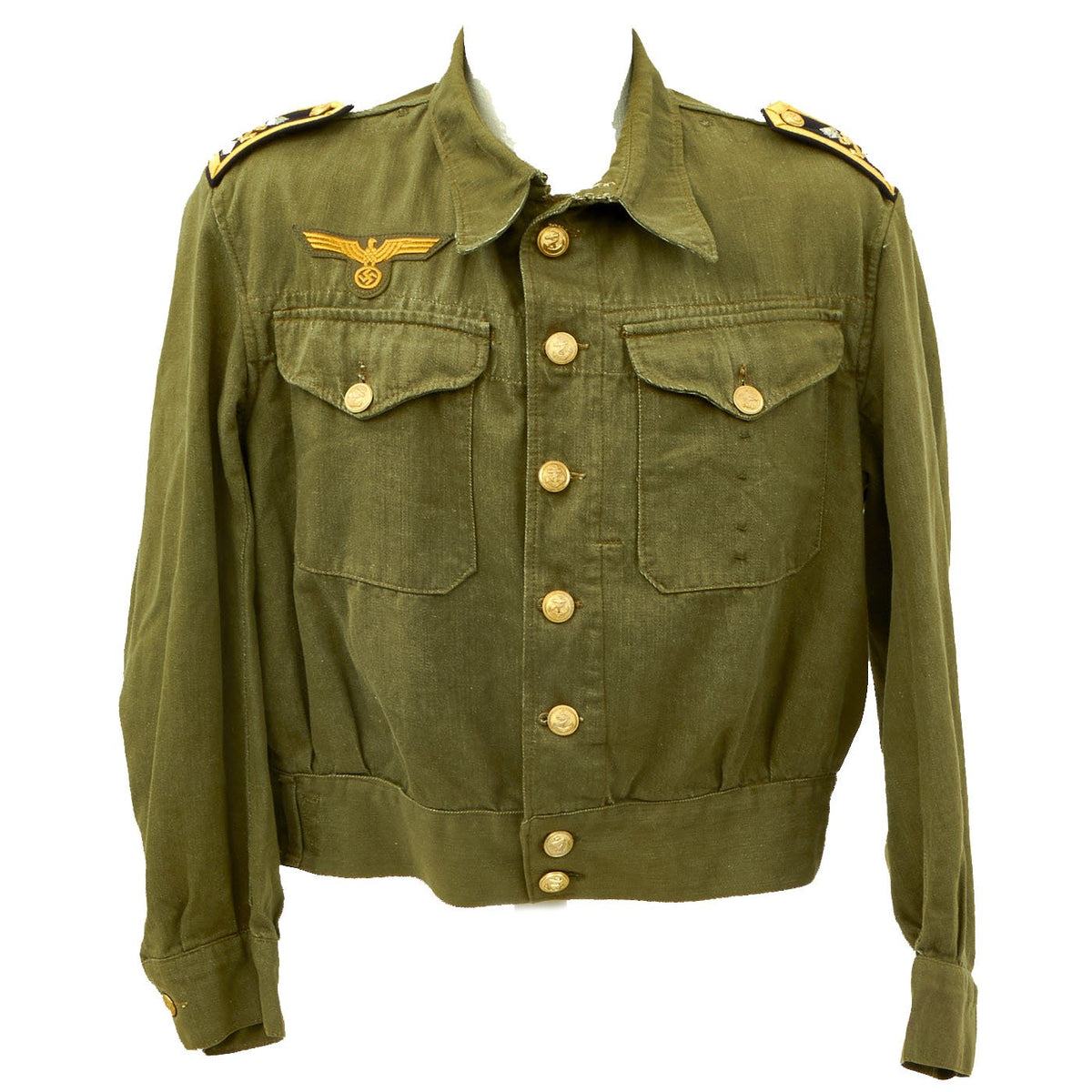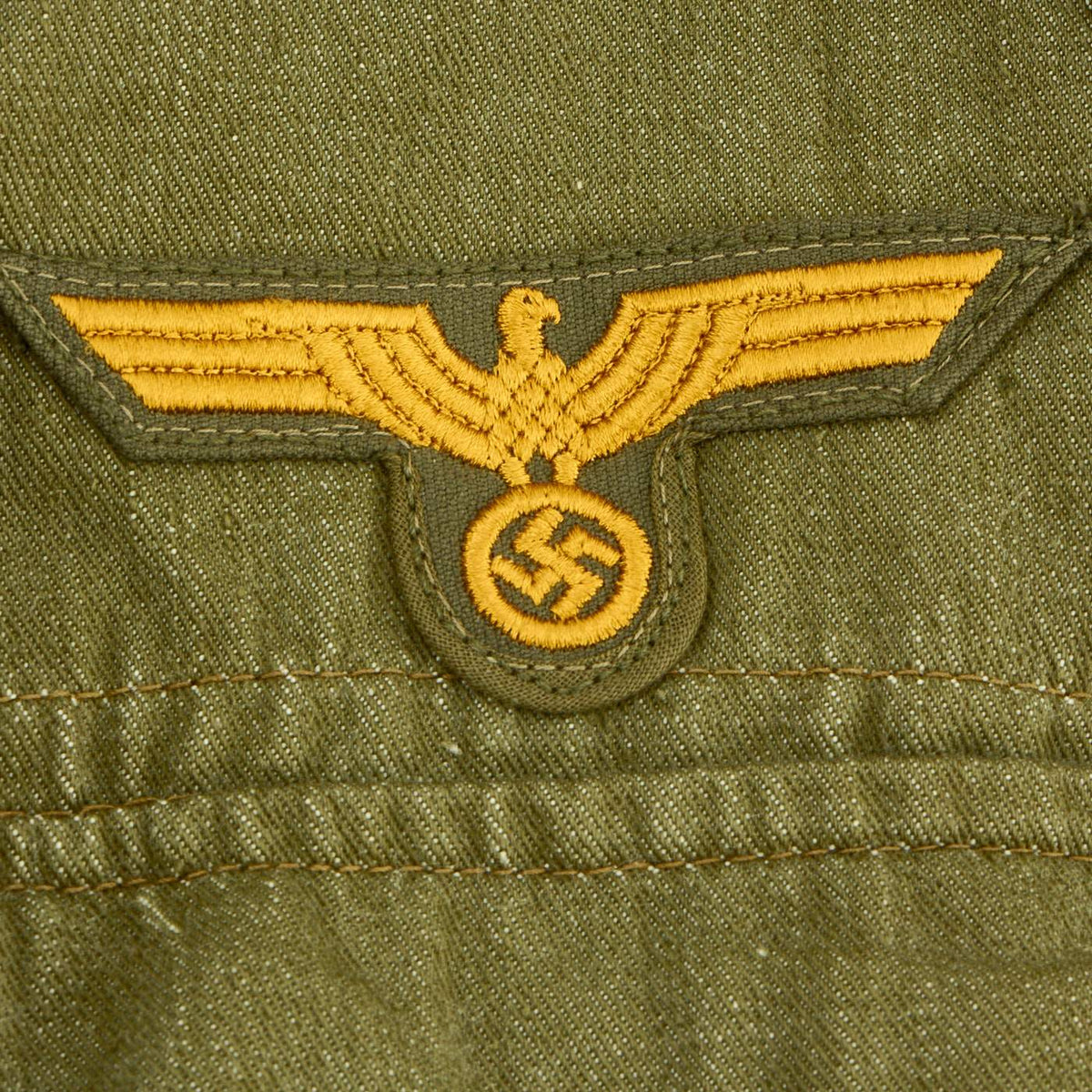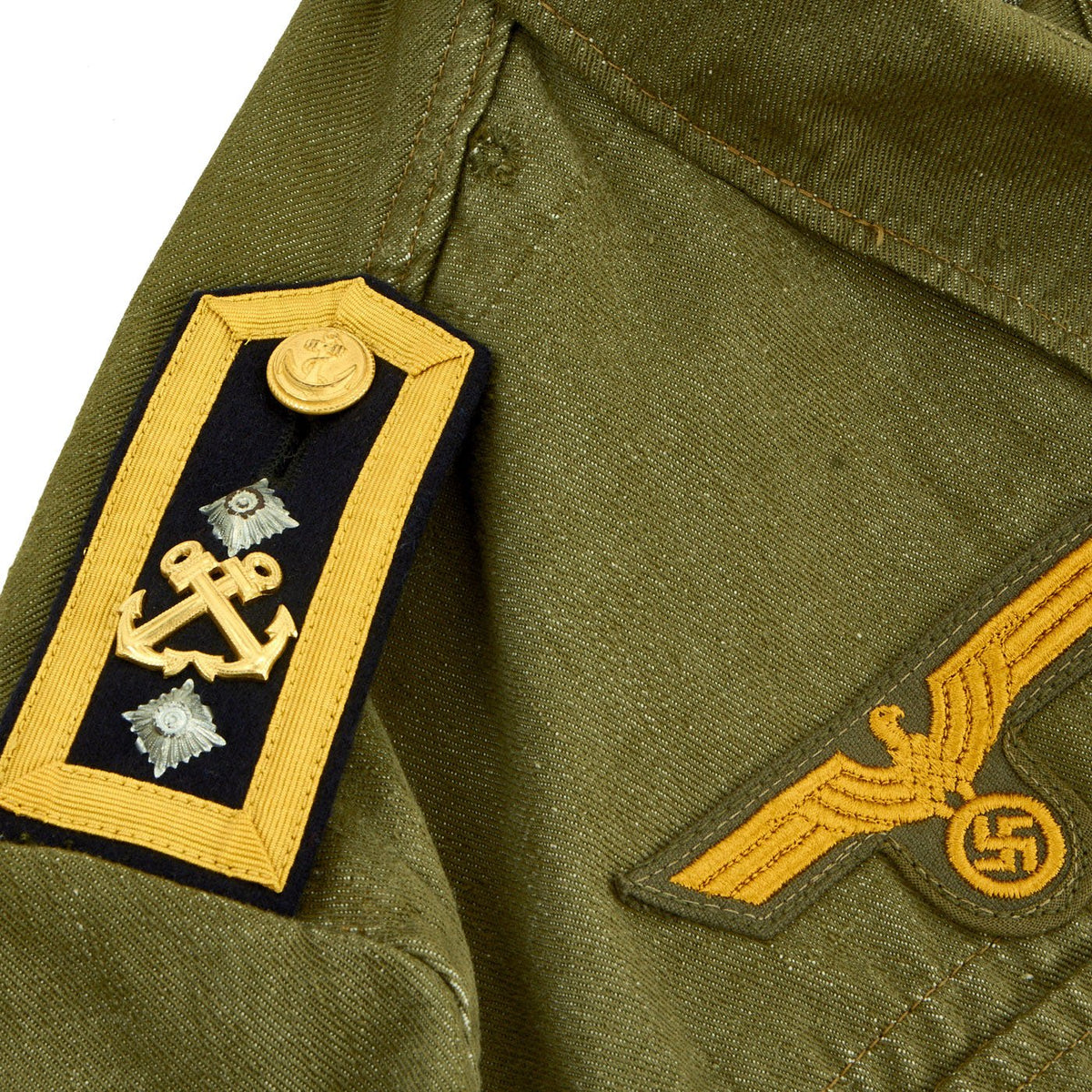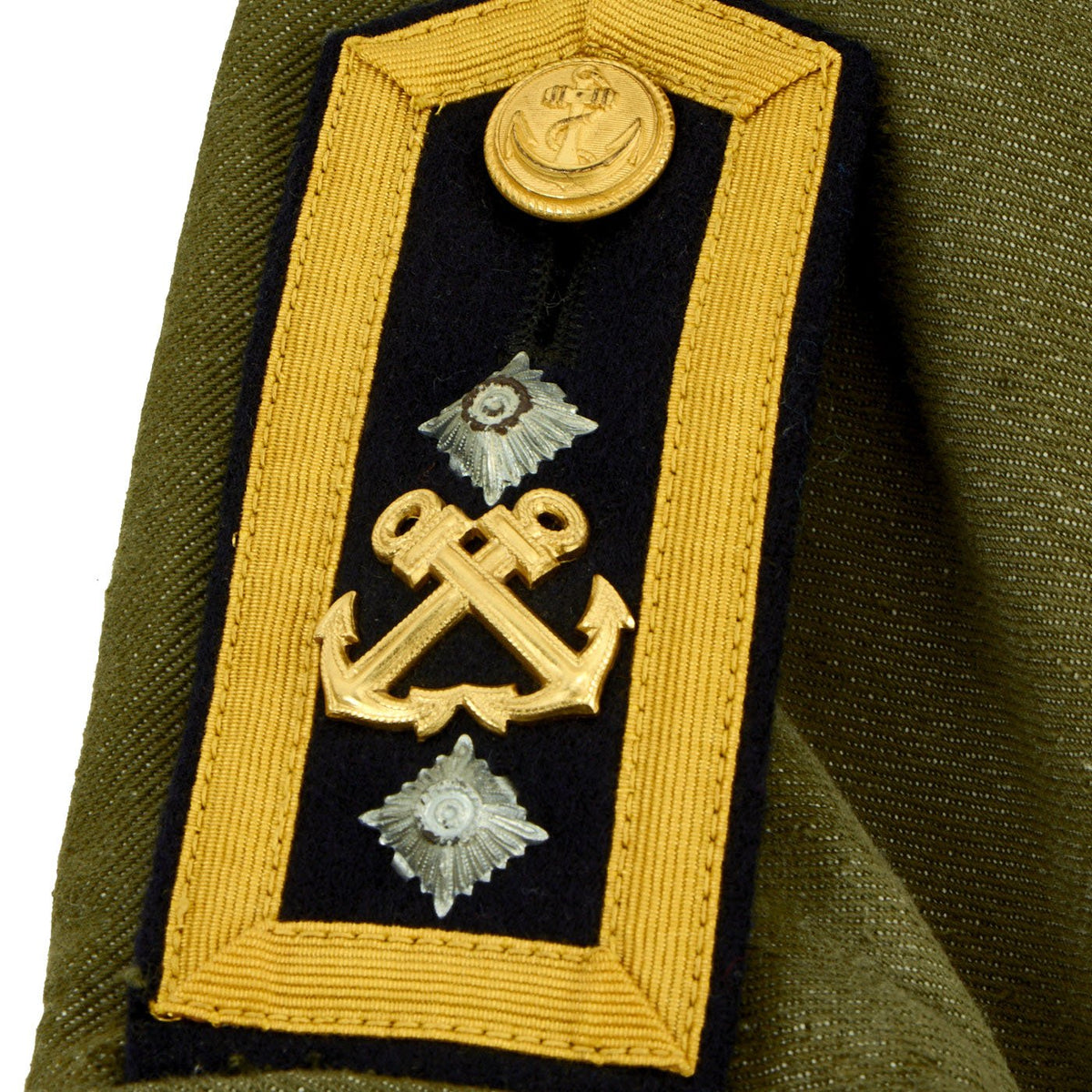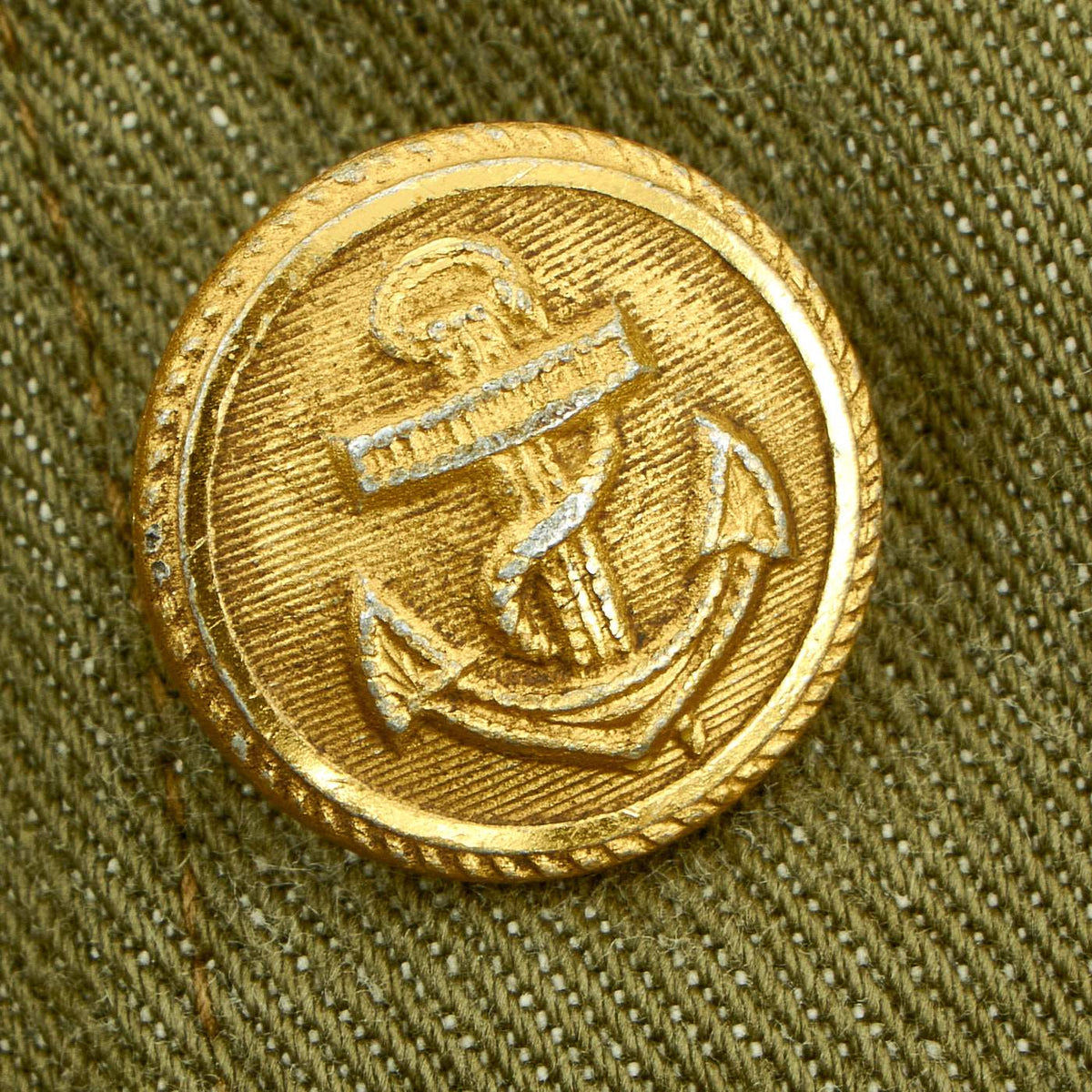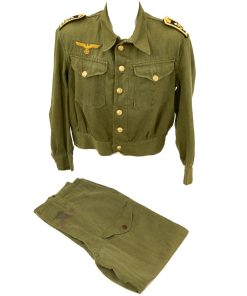Original German WWII Kriegsmarine U-Boat Crew Uniform Converted from Captured British Denim Battledress Original Items
$ 1.495,00 $ 373,75
Original Item: Only One Available. Following the British retreat from France in 1940, the Germans captured a staggering amount of British war material; vehicles, weapons, expendable supplies, equipment, and uniforms. Included in the captured stocks were Battle Dress Uniforms (serge and denim) that members of the British Army wore. The Germans liked the smartness and hard wearing utilitarian design of these uniforms, and converted them for their use, namely for crew members of U-Boats and Torpedo Boats, who had to work within the confined space of a submarine or small vessel. This particular Uniform is a Denim 1940 “Austerity” pattern uniform. Denims were intended to be worn over the usual serge uniforms worn by British troops, generally for fatigue duty. The conversion included having Kriegsmarine buttons added, as well as the addition of German insignia such as shoulder boards and a Breast Eagle. This is a prime example of such a conversion. The Glass gilt-painted Kriegsmarine buttons are removable by the means of an internal steel S-hook. The award loops were also added in order to wear two badges upon the left pocket (Most likely for a U-Boot Badge and a Wound Badge or Iron Cross 1st Class). Having loops meant that the pin of the award went through the loop and not the material of the uniform.
The Shoulder Boards denote that the original owner held the rank of Oberfeldwebel. The boards are of the sew-in variety, meaning that the shoulder seam was unstitched, the boards were added, and the seam restitched. The epaulette is trimmed with gold Kriegsmarine noncommissioned officer’s tresse, with two gold rank pips and crossed anchors, denoting the position of Boatswain.
Measurements:
Jacket:
Chest (Armpit to armpit when laid flat): 24”
Collar to Shoulder Seam: 7”
Shoulder Seam to Shoulder Seam: 18.5”
Shoulder Seam to Cuff: 23 ¾”
Collar: 19.5”
Waist: 20”
Trousers:
Waist (across the waistband when laid flat): 20.5”
Inseam (from crotch to cuff): 33.5”
During World War II, U-boat warfare was the major component of the Battle of the Atlantic, which began in 1939 and ended with Germany’s surrender in 1945. The Armistice of 11 November 1918 ending World War I had scuttled most of the old Imperial German Navy and the subsequent Treaty of Versailles of 1919 limited the surface navy of Germany’s new Weimar Republic to only six battleships (of less than 10,000 tons each), six cruisers, and 12 destroyers. To compensate, Germany’s new navy, the Kriegsmarine, developed the largest submarine fleet going into World War II.[16] British Prime Minister Winston Churchill later wrote “The only thing that really frightened me during the war was the U-boat peril.”
In the early stages of the war, the U-boats were extremely effective in destroying Allied shipping due to the large gap in mid-Atlantic air cover. Cross-Atlantic trade in war supplies and food was extensive and critical for Britain’s survival. The continuous action surrounding British shipping became known as the Battle of the Atlantic, as the British developed technical defences such as ASDIC and radar, and the German U-boats responded by hunting in what were called “wolfpacks” where multiple submarines would stay close together, making it easier for them to sink a specific target. Britain’s vulnerable shipping situation existed until 1942, when the tides changed as the U.S. merchant marine and Navy entered the war, drastically increasing the amount of tonnage of supplies sent across the Atlantic. The combination of increased tonnage and increased naval protection of shipping convoys made it much more difficult for U-boats to make a significant dent in British shipping. Once the United States entered the war, U-boats ranged from the Atlantic coast of the United States and Canada to the Gulf of Mexico, and from the Arctic to the west and southern African coasts and even as far east as Penang. The U.S. military engaged in various tactics against German incursions in the Americas; these included military surveillance of foreign nations in Latin America, particularly in the Caribbean, to deter any local governments from supplying German U-boats.
Because speed and range were severely limited underwater while running on battery power, U-boats were required to spend most of their time surfaced running on diesel engines, diving only when attacked or for rare daytime torpedo strikes. The more ship-like hull design reflects the fact that these were primarily surface vessels that could submerge when necessary. This contrasts with the cylindrical profile of modern nuclear submarines, which are more hydrodynamic underwater (where they spend the majority of their time), but less stable on the surface. While U-boats were faster on the surface than submerged, the opposite is generally true of modern submarines. The most common U-boat attack during the early years of the war was conducted on the surface and at night. This period, before the Allied forces developed truly effective antisubmarine warfare tactics, which included convoys, was referred to by German submariners as “die glückliche Zeit” or the “First Happy Time”.
Fast Shipping with Professional Packaging
Thanks to our longstanding association with UPS FedEx DHL, and other major international carriers, we are able to provide a range of shipping options. Our warehouse staff is expertly trained and will wrap your products according to our exact and precise specifications. Prior to shipping, your goods will be thoroughly examined and securely secured. We ship to thousands clients each day across multiple countries. This shows how we're dedicated to be the largest retailer on the internet. Warehouses and distribution centres can be located throughout Europe as well as the USA.
Note: Orders with more than one item will be assigned a processing date depending on the item.
Before shipping before shipping, we'll conduct a thorough inspection of the items you have ordered. Today, the majority of orders will be delivered within 48 hours. The delivery time will be between 3-7 days.
Returns
The stock is dynamic and we cannot completely manage it because multiple stakeholders are involved, including our factory and warehouse. So the actual stock may alter at any time. It's possible that you may not receive your order once the order has been made.
Our policy is valid for a period of 30 days. If you don't receive the product within 30 days, we are not able to issue a refund or an exchange.
You can only return an item if it is unused and in the same state as the day you received it. You must have the item in its original packaging.
Related products
Uncategorized
Uncategorized
Uncategorized
Armored Burgonet Helmet & Polearm from Scottish Castle Leith Hall Circa 1700 Original Items
Uncategorized
Uncategorized
Uncategorized
Uncategorized
Uncategorized
Australian WWII Owen MK1 Machine Carbine SMG Custom Fabricated Replica with Sling Original Items
Uncategorized
Uncategorized
Uncategorized
Angolan Rebel 1970s era 60mm Inert Display Mortar from Angolan Civil War Original Items
Uncategorized
Uncategorized
Band of Brothers ORIGINAL GERMAN WWII Le. F.H. 18 10.5cm ARTILLERY PIECE Original Items
Uncategorized
Uncategorized
Uncategorized
Uncategorized

